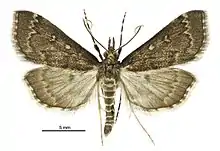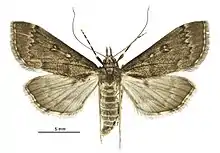Proternia
Proternia is a monotypic moth genus of the family Crambidae described by Edward Meyrick in 1884.[1] Its only species, Proternia philocapna, described by the same author in the same year, is endemic to New Zealand.[2][3][4]
| Proternia | |
|---|---|
 | |
| Male | |
 | |
| Female | |
| Scientific classification | |
| Domain: | Eukaryota |
| Kingdom: | Animalia |
| Phylum: | Arthropoda |
| Class: | Insecta |
| Order: | Lepidoptera |
| Family: | Crambidae |
| Subfamily: | Spilomelinae |
| Genus: | Proternia Meyrick, 1884 |
| Species: | P. philocapna |
| Binomial name | |
| Proternia philocapna Meyrick, 1884 | |
The wingspan is 21–26 mm. The forewings dark fuscous, somewhat mixed with paler markings and with obscurely darker fuscous lines. The first line is irregular and runs from one-third of the costa to before the middle of the inner margin. There is a small round pale-centred spot in the disc before the middle and an 8-shaped pale-centred discal spot. The second line runs from three-fourths of the costa to two-thirds of the inner margin and is followed by an obscure whitish ochreous line. There is an interrupted dark fuscous hind marginal line. The hindwings are fuscous, but darker on the hindmargin and obscurely mixed with whitish ochreous towards the base. There is also a cloudy dark fuscous discal spot and a faint irregular dentate pale posterior line.[5]
References
- Pitkin, Brian; Jenkins, Paul (November 5, 2004). "Proternia Meyrick, 1884". Butterflies and Moths of the World. Natural History Museum, London. Retrieved June 19, 2018.
- Nuss, M.; et al. (2003–2017). "GlobIZ search". Global Information System on Pyraloidea. Retrieved June 19, 2018.
- "Proternia philocapna Meyrick, 1884". www.nzor.org.nz. Landcare Research New Zealand Ltd. Retrieved 23 January 2018.
- Gordon, Dennis P., ed. (2010). New Zealand inventory of biodiversity: Kingdom animalia : chaetognatha, ecdysozoa, ichnofossils. Vol. 2. p. 458. ISBN 978-1-877257-93-3. OCLC 973607714. OL 25288394M. Wikidata Q45922947.
- Meyrick, E. (1884). "On the classification of the Australian Pyralidina". Transactions of the Royal Entomological Society of London. 32 (3): 277–350. doi:10.1111/j.1365-2311.1884.tb01610.x. ISSN 1365-2311 – via Biodiversity Heritage Library.
 This article incorporates text from this source, which is in the public domain.
This article incorporates text from this source, which is in the public domain.